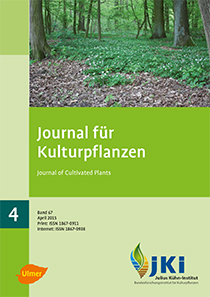Infestation status of European corn borer (<em>Ostrinia nubilalis</em>) and western corn root worm (<em>Diabrotica virgifera virgifera</em>) in their control in Germany
Keywords:
European corn borer (Ostrinia nubilalis), Western corn root worm (Diabrotica virgifera virgifera), occurrence and infestation level mapping, actual use of insecticides and biological control in GermanyAbstract
The occurrence and infestation level of European corn borer (Ostrinia nubilalis) and Western corn root worm (Diabrotica virgifera virgifera) as well as their control were analyzed in collaboration with experts of the plant protection services of German federal states in the years 2009 to 2013.
Since a monitoring of the European corn borer is not conducted in a systematic way, the infestation level was either assessed or estimated and documented using five infestation intensity groups (0: no occurrence, X: low infestation – < 10%, XX: middle infestation – 10 to 50% and high infestation – > 50% infested steams).
The European corn borer has slowly spread towards North West of Germany and occurred in approx. 90% of all administrative districts up to 2013. The share of strong infested federal states varied from year to year not showing a significant increase over the period reported. The area with applications of insecticides and biological control was estimated to be more than 40 000 ha (1.6% of maize growing area) and 27 000 ha 1% of maize growing area), respectively, in 2013. On the basis of the collected data no significant increase for control needs could be identified. Keeping insecticide use as low as possible, the possibilities of prevention, cultural and biological control measures should be further exploited.
The occurrence of Western corn root worm borer was well documented up to 2013 because of its former status as quarantine pest (monitoring by pheromone traps). The pest slowly spreads towards North. The Western corn root worm borer was determined in 34 counties (7% of all counties) by 2013. While chemical control measures were performed on 2432 ha in the year 2009, two years after the first record of pest in Germany, the insecticide use reduced to 192 ha and even only 9 ha in the years 2012 and 2013, respectively. In practice, the cultural control by crop rotation is favored by farmers and also recommended by the advisory services. Therefore the insecticide use is no necessary control option of the Western corn root worm.
Even though the experts of the German federal states assume a further spread of both maize pests, the need for chemical control will not increase. A national adapted monitoring system would be helpful to recognize possible changes of the pest status.
DOI: 10.5073/JfK.2015.04.01, https://doi.org/10.5073/JfK.2015.04.01
Downloads
Published
Issue
Section
License
The content of the journal is licensed under the Creative Commons Attribution 4.0 License. Any user is free to share and adapt (remix, transform, build upon) the content as long as the original publication is attributed (authors, title, year, journal, issue, pages).
The copyright of the published work remains with the authors. The authors grant the Journal of Cultivated Plants, the Julius Kühn-Institut and the OpenAgrar repository the non-exclusive right to distribute and exploit the work.







